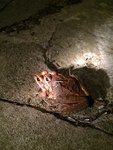 Narrowsburg
NarrowsburgLight Rain Fog/Mist, 43°
Wind: 8.1 mph
 Narrowsburg
NarrowsburgAfter seeming like it might never arrive in the Upper Delaware River region, spring has finally sprung. While walking in a forested area in Pike County, PA last week, I heard the unmistakable …
Stay informed about your community and support local independent journalism.
Subscribe to The River Reporter today. click here
This item is available in full to subscribers.
Please log in to continue |


After seeming like it might never arrive in the Upper Delaware River region, spring has finally sprung. While walking in a forested area in Pike County, PA last week, I heard the unmistakable “quacking” calls of wood frogs emanating from a vernal pool. Soon these will be followed by the riotous “eeps” of spring peepers. And although silent, salamanders are on the move, too, as the annual migration of breeding amphibians is underway.
In Pennsylvania, the National Park Service closes River Road in the Delaware Water Gap National Recreation Area periodically on rainy nights from March to mid-April to protect amphibians as they make their way to breeding pools at great risk of being crushed by vehicles.
Road closures are triggered by weather forecasts calling for evening rain and mild temperatures in the 50s. (For information on closures, call 570/426-2452; visit www.nps.gov/dewa; or follow along on Facebook at www.Facebook.com/DelWaterGapNPS).
In New York State, the Department of Environmental Conservation (DEC) has also alerted the public to the hazards encountered by amphibians in their quest for the perfect partner. The state’s Wildlife Action Plan identifies road mortality as a significant threat to frogs, toads and salamanders.
Community volunteers document their observations as part of DEC’s Amphibian Migrations and Road Crossings Project, identifying locations where migrations cross roads, recording weather and traffic conditions and counting amphibians on the go. The volunteers also carefully help them to safely cross roads. (Visit https://www.youtube.com/watch?v=dHRbsAsnQi8 or contact woodlandpool@dec.ny.gov to learn more).
Amphibians emerge after nightfall and are slow moving. Drivers in both states are encouraged to proceed with caution or avoid travel on the first warm, rainy evenings of the season to minimize mortality.
Comments
No comments on this item Please log in to comment by clicking here